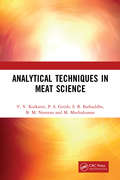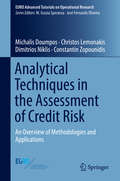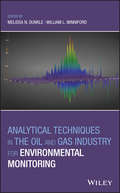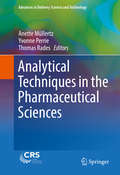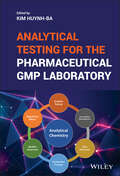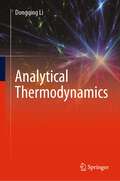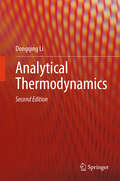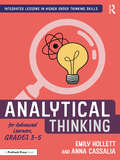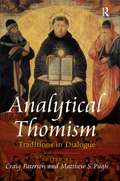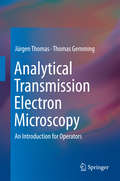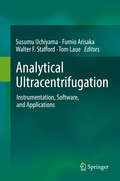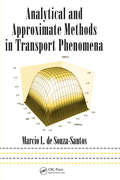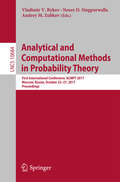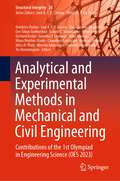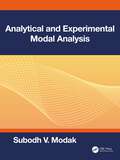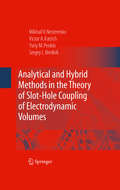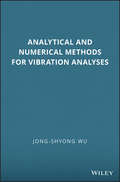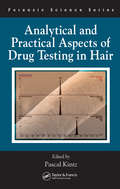- Table View
- List View
Analytical Techniques in Meat Science
by M. Muthukumar V. V. Kulkarni P. S. Girish S. B. Barbuddhe B. M. NaveenaAnalytical Techniques in Meat Science is a comprehensive compilation of all the relevant methodologies for the quality analysis of meat. The content of the book is designed to cater to requirement of meat producers, regulatory agencies, researchers, students, teachers, laboratory staff etc. It covers techniques for physico-chemical analysis, speciesidentification and microbiological examination of meat. Also, it contains the latest biotechnological and proteomic techniques for meat quality evaluation. To help the reader understand better figures, tables, line diagrams, etc are used frequently whenever needed. Some important pictures are given in plates for lucid and clear understanding of theconcept.Note: T&F does not sell or distribute the hardback in India, Pakistan, Nepal, Bhutan, Bangladesh and Sri Lanka.
Analytical Techniques in the Assessment of Credit Risk: An Overview of Methodologies and Applications (EURO Advanced Tutorials on Operational Research)
by Constantin Zopounidis Michalis Doumpos Christos Lemonakis Dimitrios NiklisThis book provides a unique, focused introduction to the analytical skills, methods and techniques in the assessment of credit risk that are necessary to tackle and analyze complex credit problems. It employs models and techniques from operations research and management science to investigate more closely risk models for applications within the banking industry and in financial markets. Furthermore, the book presents the advances and trends in model development and validation for credit scoring/rating, the recent regulatory requirements and the current best practices. Using examples and fully worked case applications, the book is a valuable resource for advanced courses in financial risk management, but also helpful to researchers and professionals working in financial and business analytics, financial modeling, credit risk analysis, and decision science.
Analytical Techniques in the Oil and Gas Industry for Environmental Monitoring
by Melissa N. Dunkle William L. WinnifordA thorough introduction to environmental monitoring in the oil and gas industry Analytical Techniques in the Oil and Gas Industry for Environmental Monitoring examines the analytical side of the oil and gas industry as it also provides an overall introduction to the industry. You’ll discover how oil and natural gas are sourced, refined, and processed. You can learn about what’s produced from oil and natural gas, and why evaluating these sourced resources is important. The book discusses the conventional analyses for oil and natural gas feeds, along with their limitations. It offers detailed descriptions of advanced analytical techniques that are commercially available, plus explanations of gas and oil industry equipment and instrumentation. You’ll find technique descriptions supplemented with a list of references as well as with real-life application examples. With this book as a reference, you can prepare to apply specific analytical methods in your organization’s lab environment. Analytical Techniques can also serve as your comprehensive resource on key techniques in the characterization of oil and gas samples, within both refinery and environmental contexts. Understand of the scope of oil and gas industry techniques available Consider the benefits and limitations of each available process Prepare for applying analytical techniques in your lab See real examples and a list of references for each technique Read descriptions of off-line analytics, as well as on-line and process applications As a chemist, engineer, instructor, or student, this book will also expand your awareness of the role these techniques have in environmental monitoring and environmental impact assessments.
Analytical Techniques in the Pharmaceutical Sciences (Advances in Delivery Science and Technology)
by Yvonne Perrie Thomas Rades Anette MüllertzThe aim of this book is to present a range of analytical methods that can be used in formulation design and development and focus on how these systems can be applied to understand formulation components and the dosage form these build. To effectively design and exploit drug delivery systems, the underlying characteristic of a dosage form must be understood--from the characteristics of the individual formulation components, to how they act and interact within the formulation, and finally, to how this formulation responds in different biological environments. To achieve this, there is a wide range of analytical techniques that can be adopted to understand and elucidate the mechanics of drug delivery and drug formulation. Such methods include e. g. spectroscopic analysis, diffractometric analysis, thermal investigations, surface analytical techniques, particle size analysis, rheological techniques, methods to characterize drug stability and release, and biological analysis in appropriate cell and animal models. Whilst each of these methods can encompass a full research area in their own right, formulation scientists must be able to effectively apply these methods to the delivery system they are considering. The information in this book is designed to support researchers in their ability to fully characterize and analyze a range of delivery systems, using an appropriate selection of analytical techniques. Due to its consideration of regulatory approval, this book will also be suitable for industrial researchers both at early stage up to pre-clinical research.
Analytical Testing for the Pharmaceutical GMP Laboratory
by Kim Huynh-BaProvides practical guidance on pharmaceutical analysis, written by leading experts with extensive industry experience Analytical Testing for the Pharmaceutical GMP Laboratory presents a thorough overview of the pharmaceutical regulations, working processes, and drug development best practices used to maintain the quality and integrity of medicines. With a focus on smaller molecular weight drug substances and products, the book provides the knowledge necessary for establishing the pharmaceutical laboratory to support Quality Systems while maintaining compliance with Good Manufacturing Practices (GMP) regulations. Concise yet comprehensive chapters contain up-to-date coverage of drug regulations, pharmaceutical analysis methodologies, control strategies, testing development and validation, method transfer, electronic data documentation, and more. Each chapter includes a table of contents, definitions of acronyms, a reference list, and ample tables and figures. Addressing the principal activities and regulatory challenges of analytical testing in the development and manufacturing of pharmaceutical drug products, this authoritative resource: Describes the structure, roles, core guidelines, and GMP regulations of the FDA and ICH. Covers the common analytical technologies used in pharmaceutical laboratories, including examples of analytical techniques used for the release and stability testing of drugs. Examines control strategies established from quality systems supported by real-world case studies. Explains the use of dissolution testing for products such as extended-release capsules, aerosols, and inhalers. Discusses good documentation and data reporting practices, stability programs, and the Laboratory Information Management System (LIMS) to maintain compliance. Includes calculations, application examples, and illustrations to assist readers in day-to-day laboratory operations. Contains practical information and templates to structure internal processes or common Standard Operating Procedures (SOPs). Analytical Testing for the Pharmaceutical GMP Laboratory is a must-have reference for both early-career and experienced pharmaceutical scientists, analytical chemists, pharmacists, and quality control professionals. It is also both a resource for GMP laboratory training programs and an excellent textbook for undergraduate and graduate courses of analytical chemistry in pharmaceutical sciences or regulatory compliance programs.
Analytical Thermodynamics
by Dongqing LiThis book provides the foundations of analytical thermodynamics for graduate level. The content is based on the author’s lecture notes developed over 30 years of academic teaching. It aims to present thermodynamics to the readers as easy to understand as possible, being suitable for professors teaching advanced thermodynamics or graduate students learning thermodynamics. The chapters include the basics of analytical thermodynamics, modelling of homogeneous and heterogeneous systems, thermodynamics of interfaces and three-phase contact lines and the Second Law in engineering thermodynamics.
Analytical Thermodynamics
by Dongqing LiThis second edition presents an enriched and expanded exploration of the fundamental principles of thermodynamics tailored for graduate-level studies. Drawing on over three decades of academic teaching experience, the author has refined the content, making it more accessible and comprehensive. Chapter 1 has been restructured for clarity, delineating "Legendre Transformation" and "Thermodynamic Potentials" into separate sections, while the treatment of "Chemical Potentials" has been significantly augmented, encompassing two-component ideal gas mixtures and a re-derivation of chemical potentials for dilute solutions. Additionally, the section on thermodynamic stability now boasts enhanced explanations and illustrative figures. Chapter 2 introduces a groundbreaking section, "Electrolyte Solution in Electric Field as a Non-Uniform System," providing fresh insights into unexplored realms. Chapter 3, now enriched with several new sections, delves into topics such as "Contact Angles on Heterogeneous Surfaces and Rough Surfaces," "Elastic Liquid-Fluid Interface," "Curvature Effect on Surface Tension," "Solute Effect on Equilibrium Pressure," and "Heterogeneous Bubble Nucleation in a Dilute Solution." Chapter 4 features new elucidations and discussions aimed at bolstering comprehension, while the entirely new Chapter 5 offers solutions to selected homework and exam questions, adding a practical dimension to the theoretical framework. This edition, encompassing approximately 50% new content, expands the book by 131 pages, rendering it an even more invaluable resource for professors instructing advanced thermodynamics and graduate students delving into this intricate subject matter.
Analytical Thinking for Advanced Learners, Grades 3–5 (Integrated Lessons in Higher Order Thinking Skills)
by Emily Hollett Anna CassaliaAnalytical Thinking for Advanced Learners, Grades 3–5 will teach students to think scientifically, systematically, and logically about questions and problems. Thinking analytically is a skill which helps students break down complex ideas into smaller parts in order to develop hypotheses and eventually reach a solution. Working through the lessons and handouts in this book, students will learn strategies and specific academic vocabulary in the sub-skills of noticing details, asking questions, classifying and organizing information, making hypotheses, conducting experiments, interpreting data, and drawing conclusions. The curriculum provides cohesive, scaffolded lessons to teach each targeted area of competency, followed by authentic application activities for students to then apply their newly developed skill set. This book can be used as a stand-alone gifted curriculum or as part of an integrated curriculum. Each lesson ties in both reading and metacognitive skills, making it easy for teachers to incorporate into a variety of contexts.
Analytical Thomism: Traditions in Dialogue
by Matthew S. PughAnalytical Thomism is a recent label for a newer kind of approach to the philosophical and natural theology of St Thomas Aquinas. It illuminates the meaning of Aquinas’s work for contemporary problems by drawing on the resources of contemporary Anglo-Saxon analytical philosophy, the work of Frege, Wittgenstein, and Kripke proving particularly significant. This book expands the discourse in contemporary debate, exploring crucial philosophical, theological and ethical issues such as: metaphysics and epistemology, the nature of God, personhood, action and meta-ethics. All those interested in the thought of St Thomas Aquinas, and more generally contemporary Catholic scholarship, problems in philosophy of religion, and contemporary metaphysics, will find this collection an invaluable resource.
Analytical Tools for Assessing the Chemical Safety of Meat and Poultry (SpringerBriefs in Food, Health, and Nutrition #9)
by Fidel Toldrá Milagro ReigThe goal of the Brief is to summarize the state of the art on the chemical safety issues currently concerning meat and poultry, and to discuss the current international legislation on the tools available for their control. The Brief will review the analytical controls and instrumentation available for the control of residues of growth promoters, antibiotics, and any other environmental substances in raw meat and poultry. In addition, there will be a discussion of both the substances that may be generated as a consequence of processing, and the tools that are available for their control. These substances may be quite varied in nature; they may include, for example, the heterocyclic amines generated by heating, the nitrosamines sometimes present in cured meats with nitrite if not properly processed, the polycyclic aromatic hydrocarbons that can be generated depending on the type of smoking used, or the biogenic amines that can be generated during fermentation. Finally, the controls for the detection of foreign proteins (e.g., whey proteins) in the final products will be also compiled. The Brief will conclude with a view of future trends and key references for readers interested in learning more about this topic.
Analytical Tools in Private Equity: Return Bridge
by Victoria Ivashina Abhijit TagadeThis note explains the rationale and derivation behind "return bridge," a key analytical tool used in the private equity industry to understand sources of value-add. The note elaborates on the advantages and the shortcomings of the return bridge.
Analytical Transmission Electron Microscopy: An Introduction for Operators
by Jürgen Thomas Thomas GemmingThis work is based on experiences acquired by the authors regarding often asked questions and problems during manifold education of beginners in analytical transmission electron microscopy. These experiences are summarised illustratively in this textbook. Explanations based on simple models and hints for the practical work are the focal points. This practically- oriented textbook represents a clear and comprehensible introduction for all persons who want to use a transmission electron microscope in practice but who are not specially qualified electron microscopists up to now.
Analytical Ultracentrifugation: Instrumentation, Software, and Applications
by Susumu Uchiyama Fumio Arisaka Walter F. Stafford Tom LaueThis book introduces analytical ultracentrifugation (AUC) as a whole, covering essential theoretical and practical aspects as well as its applications in both biological and non-biological systems. Comprehensive characterizations of macromolecules in a solution are now routinely required not only for understanding the solution system but also for producing a solution with better properties. Analytical ultracentrifugation is one of most powerful and reliable techniques for studying the biophysical behavior of solutes in solution. In the last few years, there have been steady advances made in hardware, software, and applications for AUC. This book provides chapters that cover everything essential for beginners to the most advanced users and also offer updated knowledge of the field on advances in hardware, software, and applications. Recent development of hardware described in this book covers new detection systems that give added dimensions to AUC. Examples of data analysis with essential theoretical explanations for advanced and recently updated software are also introduced. Besides AUC of biological systems including membrane proteins and biopharmaceuticals, AUC applications for non-biological questions are included. AUC studies under non-ideal conditions such as highly concentrated solutions and solutions with high salt concentration are also included. The contributors to this book are leading researchers in the fields of solution biophysics and physical chemistry who extensively employ AUC analysis for their research. From this published work, one can gain new and comprehensive knowledge of recent AUC analysis.
Analytical Writing and Thinking: Facing the Tests
by Arthur Whimbey Myra J. LindenThis textbook is designed to enhance the thinking and writing skills that students need for both academic and occupational success. It helps to prepare students for the verbal portions of the SAT, PSAT, ACT, GED, and GRE and offers tips on how to pass writing tests often required for promotion/graduation and on-the- job writing assignments.
Analytical and Approximate Methods for Complex Dynamical Systems (Understanding Complex Systems)
by Alexander TimokhaThis book presents Analytical and Approximate Methods for Complex Dynamical Systems and introduces ideas of discontinuous mapping treated as complex dynamical systems. Mathematicians of world-recognized Ukrainian scientific schools established by M.Krylov, M.Bogolyubov, Yu.Mitropolskiy, and A.Sharkovsky used to cooperate for writing the collective book whose purpose consists of illustrating a synergy of combining diverse (by idea and technique) constructive analytical and approximate approaches and methods in complex dynamical systems which are herein associated with mathematical models of networks, conflict/economic theories, sloshing, soft matter, and even levitating drops. Readers are facilitated to learn contemporary insights, fundamentals (Parts I and III), applications (Part II), and components of theories of bifurcation, synchronization/self-organization, collective dynamics, chaos, solitons, fractional differential equations, symmetry, reduced order modelling, and many others, that makes the book useful for both graduate and postgraduate students, lecturers, researchers, and even engineers dealing with multidimensional dynamic systems.
Analytical and Approximate Methods in Transport Phenomena
by Marcio L. de Souza-SantosOn the job or in the field, when facing a problem with differential equations and boundary conditions, most likely you don't have time to read through several publications in search of a method that may or may not solve your problem. Organized for quick and easy access to practical solutions, Analytical and Approximate Methods in Transport Pheno
Analytical and Computational Methods in Probability Theory: First International Conference, ACMPT 2017, Moscow, Russia, October 23-27, 2017, Proceedings (Lecture Notes in Computer Science #10684)
by Vladimir V. Rykov Nozer D. Singpurwalla Andrey M. ZubkovThis book constitutes the refereed proceedings of the First International Conference on Analytical and Computational Methods in Probability Theory and its Applications, ACMPT 2017, held in Moscow, Russia, in October 2017. The 42 full papers presented were carefully reviewed and selected from 173 submissions. The conference program consisted of four main themes associated with significant contributions made by A. D. Soloviev. These are: Analytical methods in probability theory, Computational methods in probability theory, Asymptotical methods in probability theory, the history of mathematics.
Analytical and Computational Methods in Scattering and Applied Mathematics (Chapman & Hall/CRC Research Notes in Mathematics Series #No. 417)
by Fadil Santosa Ivar StakgoldProfessor Ralph Kleinman was director of the Center for the Mathematics of Waves and held the UNIDEL Professorship of the University of Delaware. Before his death in 1998, he made major scientific contributions in the areas of electromagnetic scattering, wave propagation, and inverse problems. He was instrumental in bringing together the mathematic
Analytical and Experimental Methods in Mechanical and Civil Engineering: Contributions of the 1st Olympiad in Engineering Science (OES 2023) (Structural Integrity #28)
by Gerhard Ersdal Jayantha P. Liyanage Dimitrios Pavlou Jose A. F. O. Correia Tiago Fazeres-Ferradosa Ove Tobias Gudmestad Sudath C. Siriwardane Hirpa Lemu Vidar Hansen Mona Wetrhus Minde Chandima Ratnayake Andreas Delimitis Idriss El-Thalji Nirosha Adasooriya Samindi Samarakoon Tor HemmingsenThis book publishes contributions of the 1st Olympiad in Engineering Science (OES 2023), an international congress and contest aiming to disseminate and evaluate the recent advances in Engineering Science. The book is divided in several parts. In 'Materials Science,' readers delve into nanostructural correlations in thermochromic VO2 thin films for smart windows, as well as microstructural observations of super duplex stainless steel. The 'Marine Technology' part explores riverbed scour, wave reflection, and innovative nature-based solutions for coastal protection. 'Additive Manufacturing and Welding Technology' delves into studies on carbon fiber-reinforced polymers and fatigue properties of 3D-printed specimens. 'Structural Integrity and Structural Health Monitoring' offers insights into offshore pipeline fatigue life prediction and risk-informed decision-making for existing structures. The 'Non-destructive Testing and Evaluation' part encompasses stress monitoring, rail profile measurement, and health-monitoring approaches for debonding diagnosis. 'Dynamics and Vibrations' ventures into investigations on combined viscous and Coulomb damped systems and seismic signal analysis for landslides. 'Materials Engineering' delves into strengthening reinforced concrete members and dynamic properties of carbon fiber-reinforced polymers. 'Building Materials and Concrete Structures' cover topics like minibar reinforced concrete, impact response of reinforced columns, and residual strength of cement-based composites. 'Electronic Sensors and Intelligent Systems' showcase simulations under high voltage transmission lines, synthesis of BaxSr(1-x)TiO3, and antenna catheter modeling. 'Asset Integrity' discusses analytical and experimental analyses of buckling in aluminum columns and I-beams, lateral-torsional buckling capacity, and modulation of fluid streams. Finally, 'Climate Change and Circular Economy' addresses climate-adaptive design, circular economy integration, and eco-innovative concrete applications with recycled materials. This book provides a comprehensive overview of cutting-edge research and advancements in mechanical and civil engineering, offering valuable insights for researchers, practitioners, and enthusiasts in the field.
Analytical and Experimental Modal Analysis
by Subodh V. ModakThis book covers the fundamentals and basic concepts of analytical and experimental approaches to modal analysis. In practice, the analytical approach based on lumped parameter and finite element models is widely used for modal analysis and simulation, and experimental modal analysis is widely used for modal identification and model validation. This book is inspired by this consideration and is written to give a complete picture of modal analysis. Features: Presents a systematic development of the relevant concepts and methods of the analytical and experimental modal analyses. Covers phase resonance testing and operational modal analysis. Provides the relevant signal processing concepts. Includes applications like model validation and updating, force identification and structural modification. Contains simulations, examples, and MATLAB® programs to enhance understanding. This book is aimed at senior undergraduates/graduates, researchers, and engineers from mechanical, aerospace, automotive, civil, and structural engineering disciplines.
Analytical and Hybrid Methods in the Theory of Slot-Hole Coupling of Electrodynamic Volumes
by Victor A. Katrich Yuriy M. Penkin Sergey L. BerdnikThis book provides the reader with the possibility of rapid study and application of methods of computer analysis of electrodynamic problems. The authors address the development of analytical methods to solve the problems of diffraction of waveguide electromagnetic waves on slot coupling holes. All the authors have experience in the field and the topics addressed are based on their original research results. The book is written in a laconic style and is visually accessible.
Analytical and Numerical Methods for Nonlinear Fluid Flow Problems in Porous Media
by Weiyao Zhu Jun Yao Wenchao LiuThis book investigates in detail the mathematical methods and computation methods in efficient solution of some open nonlinear seepage flow problems involved in engineering problems. Developed engineering technologies and some relevant practical field applications are also provided. The introduced open nonlinear problems include nonlinear quadratic pressure gradient term problem, compressible gas seepage flow problem and low-velocity non-Darcy seepage flow problem. Studies on these nonlinear seepage flow problems have attracted engineers and scientists from various disciplines, such as geo-energy engineering, civil and environmental engineering, fluid mechanics, applied mathematics and computation. In particular, the book systematically establishes a fundamental theory for a strongly nonlinear problem of low-velocity non-Darcy seepage flow from a new perspective of moving boundary, while emphasizing the usage of mathematical linearization transformation methods and computational methods into the analytical and numerical solution of the strongly nonlinear partial differential equations. Sufficient knowledge of mathematics is always introduced ahead of model solution to assist readers. And the procedure of strict formula deduction in the model solution process is provided in detail. High-solution figures and tables from model solution are rich in the book. Therefore, it is very helpful for the readers to master the nonlinear model solution methods and engineering technologies. The book is intended for upper undergraduate students and graduate students who are interested in engineering technology, fluid mechanics and applied mathematics, researchers and engineers working on geo-energy science and engineering and field applications.
Analytical and Numerical Methods for Vibration Analyses
by Jong-Shyong WuIllustrates theories and associated mathematical expressions with numerical examples using various methods, leading to exact solutions, more accurate results, and more computationally efficient techniques This book presents the derivations of the equations of motion for all structure foundations using either the continuous model or the discrete model. This mathematical display is a strong feature of the book as it helps to explain in full detail how calculations are reached and interpreted. In addition to the simple 'uniform' and 'straight' beams, the book introduces solution techniques for the complicated ‘non uniform’ beams (including linear or non-linear tapered beams), and curved beams. Most of the beams are analyzed by taking account of the effects of shear deformation and rotary inertia of the beams themselves as well as the eccentricities and mass moments of inertia of the attachments. Demonstrates approaches which dramatically cut CPU times to a fraction of conventional FEM Presents "mode shapes" in addition to natural frequencies, which are critical for designers Gives detailed derivations for continuous and discrete model equations of motions Summarizes the analytical and numerical methods for the natural frequencies, mode shapes, and time histories of straight structures rods shafts Euler beams strings Timoshenko beams membranes/thin plates Conical rods and shafts Tapered beams Curved beams Has applications for students taking courses including vibration mechanics, dynamics of structures, and finite element analyses of structures, the transfer matrix method, and Jacobi method This book is ideal for graduate students in mechanical, civil, marine, aeronautical engineering courses as well as advanced undergraduates with a background in General Physics, Calculus, and Mechanics of Material. The book is also a handy reference for researchers and professional engineers.
Analytical and Practical Aspects of Drug Testing in Hair (International Forensic Science and Investigation)
by Pascal KintzWritten by well-known, international authors, this comprehensive reference provides practical coverage of the best hair drug testing techniques and examines the drugs themselves. The authors review all new developments, the validation of analytical procedures, and the interpretation of data. Some of the applications discussed include doping, drug-facilitated crime investigating, workplace testing, and the granting of drivers' licenses. The authors describe specific drugs, such as opiates, cocaine, and cannabis, and discuss the different testing methods of them. The book also covers postmortem toxicology, pitfalls created by passive exposure, and testing for metals, including inductively coupled plasma spectrometry (ICP-MS), hair multielemen
